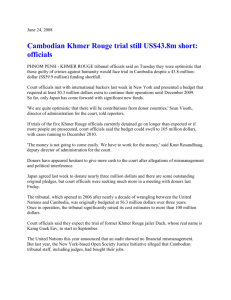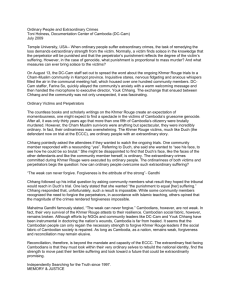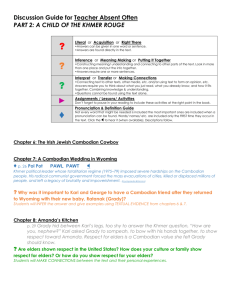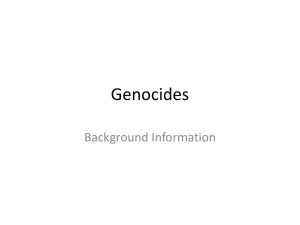Better Late Than Never: Delivering Long Overdue
advertisement
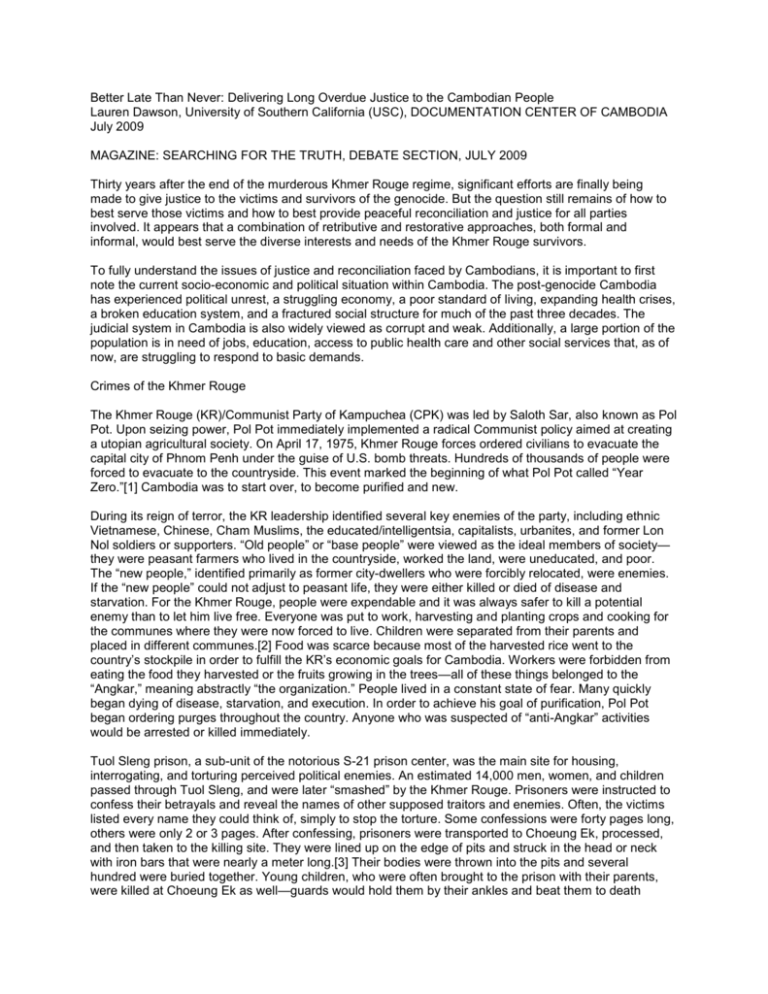
Better Late Than Never: Delivering Long Overdue Justice to the Cambodian People Lauren Dawson, University of Southern California (USC), DOCUMENTATION CENTER OF CAMBODIA July 2009 MAGAZINE: SEARCHING FOR THE TRUTH, DEBATE SECTION, JULY 2009 Thirty years after the end of the murderous Khmer Rouge regime, significant efforts are finally being made to give justice to the victims and survivors of the genocide. But the question still remains of how to best serve those victims and how to best provide peaceful reconciliation and justice for all parties involved. It appears that a combination of retributive and restorative approaches, both formal and informal, would best serve the diverse interests and needs of the Khmer Rouge survivors. To fully understand the issues of justice and reconciliation faced by Cambodians, it is important to first note the current socio-economic and political situation within Cambodia. The post-genocide Cambodia has experienced political unrest, a struggling economy, a poor standard of living, expanding health crises, a broken education system, and a fractured social structure for much of the past three decades. The judicial system in Cambodia is also widely viewed as corrupt and weak. Additionally, a large portion of the population is in need of jobs, education, access to public health care and other social services that, as of now, are struggling to respond to basic demands. Crimes of the Khmer Rouge The Khmer Rouge (KR)/Communist Party of Kampuchea (CPK) was led by Saloth Sar, also known as Pol Pot. Upon seizing power, Pol Pot immediately implemented a radical Communist policy aimed at creating a utopian agricultural society. On April 17, 1975, Khmer Rouge forces ordered civilians to evacuate the capital city of Phnom Penh under the guise of U.S. bomb threats. Hundreds of thousands of people were forced to evacuate to the countryside. This event marked the beginning of what Pol Pot called “Year Zero.”[1] Cambodia was to start over, to become purified and new. During its reign of terror, the KR leadership identified several key enemies of the party, including ethnic Vietnamese, Chinese, Cham Muslims, the educated/intelligentsia, capitalists, urbanites, and former Lon Nol soldiers or supporters. “Old people” or “base people” were viewed as the ideal members of society— they were peasant farmers who lived in the countryside, worked the land, were uneducated, and poor. The “new people,” identified primarily as former city-dwellers who were forcibly relocated, were enemies. If the “new people” could not adjust to peasant life, they were either killed or died of disease and starvation. For the Khmer Rouge, people were expendable and it was always safer to kill a potential enemy than to let him live free. Everyone was put to work, harvesting and planting crops and cooking for the communes where they were now forced to live. Children were separated from their parents and placed in different communes.[2] Food was scarce because most of the harvested rice went to the country’s stockpile in order to fulfill the KR’s economic goals for Cambodia. Workers were forbidden from eating the food they harvested or the fruits growing in the trees—all of these things belonged to the “Angkar,” meaning abstractly “the organization.” People lived in a constant state of fear. Many quickly began dying of disease, starvation, and execution. In order to achieve his goal of purification, Pol Pot began ordering purges throughout the country. Anyone who was suspected of “anti-Angkar” activities would be arrested or killed immediately. Tuol Sleng prison, a sub-unit of the notorious S-21 prison center, was the main site for housing, interrogating, and torturing perceived political enemies. An estimated 14,000 men, women, and children passed through Tuol Sleng, and were later “smashed” by the Khmer Rouge. Prisoners were instructed to confess their betrayals and reveal the names of other supposed traitors and enemies. Often, the victims listed every name they could think of, simply to stop the torture. Some confessions were forty pages long, others were only 2 or 3 pages. After confessing, prisoners were transported to Choeung Ek, processed, and then taken to the killing site. They were lined up on the edge of pits and struck in the head or neck with iron bars that were nearly a meter long.[3] Their bodies were thrown into the pits and several hundred were buried together. Young children, who were often brought to the prison with their parents, were killed at Choeung Ek as well—guards would hold them by their ankles and beat them to death against a tree, then bury them in mass graves. Such mass graves have been discovered all across the Cambodian countryside. An estimated 1.7 million people, over 20% of the population, died at the hands of the Khmer Rouge between 1975 and 1979. It is estimated that 100% of all ethnic Vietnamese were killed or forced out of the country, 40% of Cham Muslims were killed, and 50% of ethnic Chinese.[4] Restorative Justice Restorative justice will be critical to reconciliation for Cambodians. Restorative justice aims to establish lasting peace after conflict and preventative problem solving through the active participation of victims, offenders, and the overall community in the reconciliation processes. It is dependent upon personal involvement and participation of these groups and it requires that the conflict be viewed within its particular social context. Restorative justice is centrally concerned with restoring the victim (financially, emotionally, and socially) and the community and with restoring the offenders to law-abiding lives. Ideally, these processes should take place in conjunction with the proceedings of recognized justice agencies. Retributive Justice Retributive justice seeks to settle conflict by imposing proportional punishments for specific offenses. Retributive justice is based upon the principle that the wrongness of the criminal act justifies the imposition of punishment on the offender. However, retributive justice does not seek peace—for victims or for offenders. Instituting punishment in order to discourage further rule breaking or to influence behavior does little to rehabilitate offenders or provide reconciliation for the victims. Rather than promoting healing and restoring offenders to lawful society, punishment can increase anger, resentment, and alienation from society, making offenders more likely to commit another crime. Therefore, retributive justice alone will not serve the interests of peaceful reconciliation. The Justice the Survivors want Nhim Savath: Former Lon Nol Soldier & Victim of the KR Nhim Savath is a 69-year-old male living in Kok Kruos Village, Prey Taom, Kompong Ro. He was a student and then served as a Lon Nol soldier from 1972 until 1975. Savath was evacuated by the KR as a prisoner of war and then moved to another province three months later to work on building a dam. He was reunited with his wife at one of the work camps. Having lost so much to the Khmer Rouge, Nhim Savath found solace in knowing that he was not the only one who suffered. Thinking about others who had lost their children, family, and friends helped him to move forward and heal. On the topic of healing, Savath offered the following insight: “Unity between the people is important for helping the country move on. It is the unity that will help them. For example, I joined the local committee to rebuild the pagoda in this area. Having a common goal of focus—having unity—is important…Religion is also a very important aspect of healing. After all, religion is one of the three things named in the country’s motto: ‘Nation, Religion, and King’…People should share the same ideas, like uniting with the goals of the government in order to create the unity needed for healing. We just need unity.” Savath learned about the Khmer Rouge Trials (the ECCC) earlier in 2009 through one of DC-Cam’s Living Documents projects in his area. He believes the courts can decide what to do with Duch, Ieng Sary, Nuon Chea, and others, and he hopes that the judges are fair and capable so that they can bring justice to Cambodia. When asked what he would do if he were the judge, Savath stated that he would “execute the people on trial…put the KR leadership to death.” However, he believes that only the top KR leaders should be prosecuted and condemned. The lower level cadres “were only following orders from their superiors.” He agrees that the trials are one way for the Cambodian people to unite—and thus to heal—because the law gives them unity but he also believes that it is vital to teach future generations about what happened under the Khmer Rouge. He wants to see children educated about the history of the KR “to prevent it from happening again.” Chea Mao: Former KR Child Soldier & S-21 Prison Guard Chea Mao is a 59-year-old male living in Kampong Chhang province. He was forced to join the Khmer Rouge liberation army when he was 12 years old and he was taken away from his home in 1973. Eventually, he was assigned as a guard outside the walls of Tuol Sleng prison to provide security. Chea Mao believes that the victims of the Khmer Rouge deserve justice. He considers himself a victim, rather than a perpetrator, and asserts that he was simply following orders. Chea Mao does not want to take revenge because “vindictiveness is not good.” Even when he had the chance to seek revenge, he says he chose not to. When asked about what justice should look like for Cambodia, Mao explained: “The people who died did so with dignity, but those who survived do not have dignity because they keep thinking about those who died. There is no dignity in surviving. I keep thinking of every person who died during the Khmer Rouge…I still dedicate food to my parents at the pagoda. I think about it every day…[As for the KR trials], from a legal perspective, I do not care—let [Duch] face the trial because he did something bad. But from the Buddhist perspective, let him face the karma…The people who did the bad things will face the same consequences in the next life.” Mao had little information about the trials and, for the most part, seemed uninterested in the proceedings. His main concern is for the present state of his life. He says he does not have peace of mind because he is still in poverty—he cannot have peace until he no longer lives below the poverty line. For him, therefore, justice, trial proceedings, reconciliation efforts, and the international community are irrelevant. Mayane: Former Community Leader & Victim of the KR Mayane is a 65-year-old woman living in Phnom Penh. She and her husband were evacuated from Phnom Penh on April 17, 1975. They were told not to bring any of their belongings with them because they would be returning in three days. Mayane has been watching the ECCC proceedings on television but she does not know whether the trials are positive or negative. Before the trials, people did not focus on the Khmer Rouge. Now that the trials are taking place, it seems to her that people are thinking more about the genocide and the past. She is dissatisfied with the slow progress and feels that the trials are so far removed from the genocide that it is difficult to feel like justice is being served. Mayane says the trials would have been much more helpful had they taken place immediately after the Khmer Rouge period. But for now, she wants to see future generations educated about the genocide. She would like to see parents tell their children about the past: “Everyone’s experience is different. Each family should write down its own history to tell its own story.” Him Huy: Former Head of the Special Unit at S-21 Him Huy is a 54-year-old male from Kbal Chroy village. Until 1972, he was a student at the local school and helped his parents with the farming. In 1972, he was conscripted into the revolutionary army. In 1976, he was told he was being transferred to the Navy, but he was actually taken to Tuol Sleng with a group of other cadres. He remained at S-21 for several days when prison units were established: “after all of the units were established, many prisoners from Division 703, our offices, and even staff at Tuol Sleng were arrested and questioned.” Huy’s unit was often in charge of transporting prisoners from S-21 to Choeung Ek, where they were killed and buried in mass graves. Upon arriving at Choeung Ek, he was in charge of recording every name and then taking the list back to Sous Thy at S-21. When asked if he feels responsible for his actions under the KR or if he had any regrets, he responded: “No, I don’t feel responsible. I had a plan [for rebellion]. I did the best I could. When [the plan] failed, my hope left. You could ask me, ‘Did I have a choice?’ But no, I had no choice…During that period I regret all the things that happened. It is always in my heart and in my mind. It was really bad. I never thought that I would survive the regime.” He repeatedly insisted that he and the other cadres had no choice, that they were just following orders, and that they could not be held responsible for what happened. According to Huy, only Duch should be responsible and only Duch is at fault for the crimes committed. He agrees that future generations should be educated about the KR: “I think it is important—education is the only way out. Being uneducated leads to darkness. I want my children to know.” When asked about what he would need in order to find personal peace, Him Huy responded: “It is a painful memory, what happened at Tuol Sleng…There were so many times that I wanted to commit suicide…But I knew that if I pulled the trigger they would go after my family and kill them, too…There is no way for me to feel at peace unless [people] stop asking me questions. Just stop asking me questions. Then I will have peace.” About the Extraordinary Chambers in the Courts of Cambodia Established in 2003 after the Cambodian National Assembly passed a law for its creation (in 2001), the Extraordinary Chambers in the Courts of Cambodia (or ECCC) was created to prosecute the crimes committed during the Khmer Rouge regime (1975-79). It is a mixed tribunal jointly created by the Cambodian government and the United Nations, though it is meant to be independent of both. It is a “Cambodian court with international participation that will apply international standards.”[5] There has been chronic controversy over the ECCC, primarily focused on the misappropriation of funds and reports of corruption. The ECCC incorporates aspects of traditional retributive justice by seeking a conviction and subsequent punishment (retribution) for wrongs committed. However, it also seeks to incorporate aspects of restorative justice through outreach and victim participation programs. Through these programs, survivors from around the country are brought to witness the court’s proceedings. Outreach materials, including information booklets, pamphlets, posters, t-shirts, stickers, etc. have also been distributed in the provinces. These materials provide information about the court and the trial proceedings and aim to raise awareness about the ECCC and encourage victim participation. Survivors are also given assistance in filing official statements/complaints with the court, if they so desire. Additionally, speaking events, village meetings, and interviews with radio programs like Voice of America (VOA) have been organized to increase public awareness and attention. The need for both Retributive and Restorative Justice for Cambodia A common theme present in the interviews mentioned earlier was that of shared experiences. Nearly all of the interviewees mentioned—and others not mentioned here—voluntarily spoke of finding solace in remembering that they were not alone in their suffering, and that others around them had suffered the same or worse. Thus, as expressed by Mayane in her interview, sharing one’s experiences with others is key to creating an open environment that allows for building peace through fellowship. DC-Cam helped to initiate one such program through the dramatic play called “Breaking The Silence.” The play tells the stories of different survivors of the Khmer Rouge, ranging from a young girl raped by KR cadres, to child soldiers conscripted into the KR, to a son desperate to find his father’s burial site. The play also incorporates traditional Cambodian songs, interspersed with the different stories and interactions between characters. Performances are organized and presented before local communities. The play is one way to encourage dialogue about the genocide and individual experiences. It allows the audience to look at the past through the eyes of multiple people with different histories, roles, and reactions to the past. The play also encourages viewers to take ownership for their personal experiences and the experiences of their families. These performances should be more widespread, presented to more audiences, and perhaps altered to include even more characters and perspectives. Helping communities facilitate open forums after the performances to allow people to discuss their reactions or share their own stories with others could also prove beneficial. According to Suzannah Linton’s conclusions on a study conducted by DC-Cam in 2002, “Cambodians want to be reconciled with the Khmer Rouge/CPK and move together towards a better future…Forgiveness is very important; it is key for reconciliation.”[6] But as the study revealed, forgiveness does not mean forgetting what happened. Rather, it seems that forgiveness means finding some resolution to one’s own experience, “putting aside the negative and destructive feelings,” and then moving forward toward a healthy existence.[7] This perspective seems to be widely accepted among Cambodians because it is based in Buddhist teachings. It is important to note that this perspective does not necessarily conflict with commonly held feelings of anger or hatred towards the Khmer Rouge. That is, individuals may experience feelings of anger towards the KR on a daily basis while simultaneously recognizing the need to forgive. Additionally, it is possible for survivors to forgive individual Khmer Rouge that caused them harm while still maintaining hatred towards the leaders or the Khmer Rouge violence.[8] Survey respondents also recognized reconciliation as a multi-faceted process that involves both personal healing and a collective effort to live peacefully together and work towards a common future. The ideas and beliefs expressed by respondents through this survey closely align with the ideology of restorative justice. However, most respondents also agreed that people must take responsibility for the wrongs committed—“and most respondents equated this with individual criminal responsibility in a court of law.”[9] In a study conducted by the University of California-Berkley, respondents were asked about what they felt needs to happen before they can forgive the top KR leaders. Of the respondents who lived under the KR, 41.8% said the leaders must be punished, whereas 23.9% said they can never forgive the leaders. 12.3% said the leaders must confess and tell the truth, and 5.4% said the leaders must apologize.[10] Of the respondents who did not live under the KR, 33.1% said the leaders must be punished, 19.9% said they could not be forgiven, 10.9% said they must apologize, and 10.0% said they must compensate survivors. Based on the study, it seems that Cambodians want to see the former Khmer Rouge leaders held accountable for their crimes, and that (for many respondents) some form of punishment must precede forgiveness. Most respondents wanted to see accountability taken by those who committed violent acts, specifically killing, starvation, forced labor, and torture. The largest number of respondents (48.9%) said they would like to see those responsible put on trial; 22.8% said they want to see them punished; 12.4% want the leaders to be imprisoned; and 12% want them executed.[11] Based on these results, it appears that the most effective approach to justice and reconciliation involves a combination of restorative and retributive justice practices, similar to the current ECCC efforts underway. However, it would also be beneficial to expand the current efforts to incorporate a broader base of Cambodians, particularly those who fall outside the groups wanting some form of punishment as justice. Increasing restorative justice programs is essential to providing effective resolutions for more people. It is important to remember that no single approach will satisfy all victims. Thus, a plan that integrates multiple approaches will better serve the needs of the diverse victim population. Therefore, in addition to the hybrid tribunal, facilitating forums for discussion between victims and perpetrators could encourage reconciliation and peace, especially for those individuals who expressed desires to see former perpetrators confess and/or apologize for their roles. Additionally, such interactions may foster greater understanding between victims and perpetrators and allow each party to feel compassion for the other’s experience—particularly in cases where an individual is both victim and perpetrator. As both Mayane and Nhim Savath noted, focus on the future can help individuals and the community as a whole to build a new peace. Common goals can unite former enemies and bring together people with otherwise very different beliefs. Organizing community projects, such as revitalizing infrastructure or creating communal welfare programs or rebuilding pagodas, is one way to create goal-oriented cooperation. Cambodians could also take the initiative to increase awareness of the Khmer Rouge history by recording their own stories (as suggested by Mayane), participating in the survivor outreach programs with the ECCC, or organizing remembrance events for the community. In tourism-heavy areas, such as Siem Reap, information about the Khmer Rouge could be incorporated into guided tours. For example, tour guides could educate visitors about the protection of Angkor Wat during the KR and the impact of the violence on surrounding areas. The KR touched every corner of Cambodia and visitors, like Cambodians, should learn about the country’s turbulent history in order to give a voice to the survivors and increase awareness so that this gruesome history will not repeat itself. [1] “Cambodia Genocide (Pol Pot).” United Human Rights Council. 26 June 2009. http://www.unitedhumanrights.org/Genocide/pol_pot.htm [2] Ibid. [3] Maguire, Peter. “Angkar Is More Important to Me Than My Father and Mother.” Facing Death in Cambodia. New York: Columbia University Press, 2005: 65. [4] Zimmer, Zachary, John Knodel, Kiry Sovan Kim, Sina Puch. “The Impact of Past Conflicts and Social Disruption on the Elderly in Cambodia.” Population and Development Review 32.2 (2006): 347. [5] “Introduction: ECCC.” Extraordinary Chambers in the Courts of Cambodia. 26 June 2009 http://www.eccc.gov.kh/english/about_eccc.aspx . [6] Linton, Suzannah. Reconciliation in Cambodia. Cambodia: Documentation Center of Cambodia, 2004. 226-227. [7] Ibid, 227. [8] Pham, Phuong, Patrck Vinck, Mychelle Balthazard, Sokhom Hean, Eric Stover. “So We Will Never Forget.” Human Rights Center, UC-Berkley, January 2009. 29 [9] Linton 227. [10] Pham 30. [11] Ibid, 32. Independently Searching for the Truth since 1997. MEMORY & JUSTICE
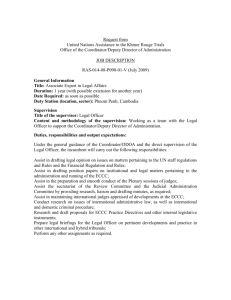
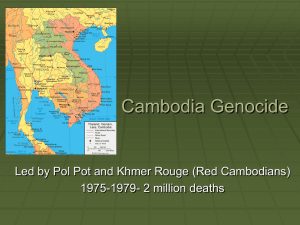
![Cambodian New Year - Rotha Chao [[.efolio.]]](http://s2.studylib.net/store/data/005298862_1-07ad9f61287c09b0b20401422ff2087a-300x300.png)
